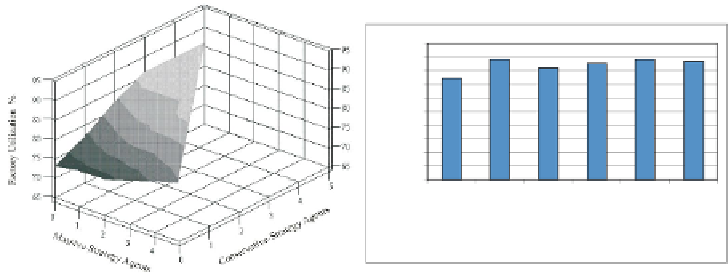Information Technology Reference
In-Depth Information
100
89
83
85
86
88
90
75
80
70
60
50
40
30
20
10
0
(a)
(b)
Fig. 5.
(a) Average factory utilisation for Socrates agents playing against M-S and C-S agents. (b)
Factory utilisation in experiments using the MAMS-PG-SS strategy.
•
Socrates Agents. These use the Multi-Attempt Massive Strategy with Prediction of
Gaps which orders big quantities at the beginning and fills the gaps throughout the
game to maintain 100% factory utilisation (section 3).
Fig. 4(a) shows the 21 different scenarios used in the experiments, in which we
have all the possible combinations of C-S, M-S and Socrates agents for a TAC 6-player
game. The first line of the table indicates the number of C-S agents, the first column the
number of M-S agents, while the main part of the table indicates the number of Socrates
agents in the game. We ran 50 games for each scenario to test the performance of the
agents in the different environments.
Fig. 4(b) shows the average of factory utilisation for Socrates agents in each sce-
nario. For example for a game with 2 C-S agents and 1 M-S agent there are 3 Socrates
agents, which achieve in average a factory utilisation of 84%. When there is more than
1 Socrates agent in a game we take the average of factory utilisation. Fig. 4(b) indicates
that in non-competitive environments the factory utilisation for Socrates agents is better
than that in competitive environments. We define a non-competitive environment as the
environment in which the number of C-S agents is less than the sum of M-S agents and
Socrates agents:
(# of C-S agents)
<
(# of M-S agents) + (Socrates agents)
Those environments in which the sum of M-S agents and Socrates agents is greater
than the number of C-S agents are referred to as “competitive”. Fig. 5(a) graphically
illustrates the results from Fig. 4(a) in which as one can observe the more Socrates
agents playing in a game (including M-S agents), the more competitive the environ-
ment is. The z axis in Fig 5(a) shows the average percentage of factory utilisation for
Socrates agents, which demonstrates that they behave much better in non-competitive
environments than they do in competitive ones.
One of the main weaknesses of the supplier strategies that were considered and tested
during TAC SCM is their inability to adapt dynamically to conditions in the game
that affect the procurement of components. One possibility was to allow the agent to

